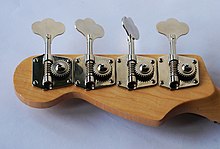Headstock
The main function of a headstock is to house the tuning pegs or other mechanism that holds the strings at the "head" of the instrument; it corresponds to a pegbox in the violin family.
Machine heads on the headstock are commonly used to tune the instrument by adjusting the tension of strings and, consequently, the pitch of sound they produce.
The advantages and disadvantages of both trends are very debatable and subjective, so these two variants are used: Luthiers of both styles frequently cite better sound, longer sustain and strings staying in tune longer as advantages of each style.
Some guitars without machine heads (for example, ones equipped with Floyd Rose SpeedLoader) have a headstock for purely decorative reasons.
As seen in a section below, even "copied" at the first glance designs retain clear visible changes in dimensions, proportions of elements, etc., so it is almost always possible to tell a major brand of a guitar by looking at the headstock.







